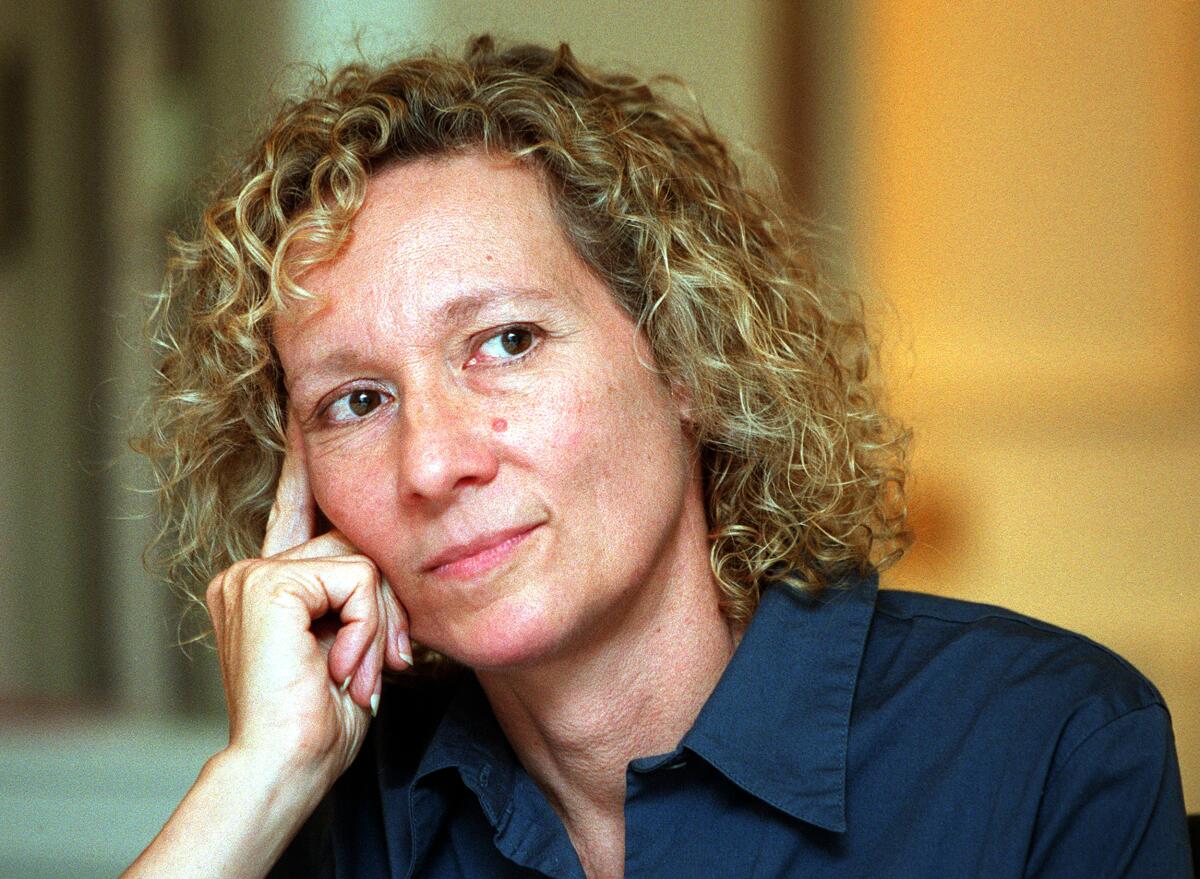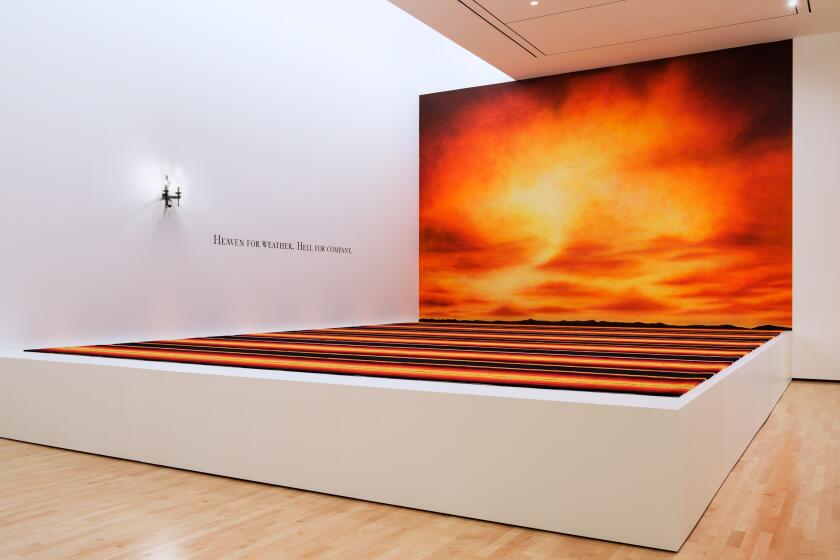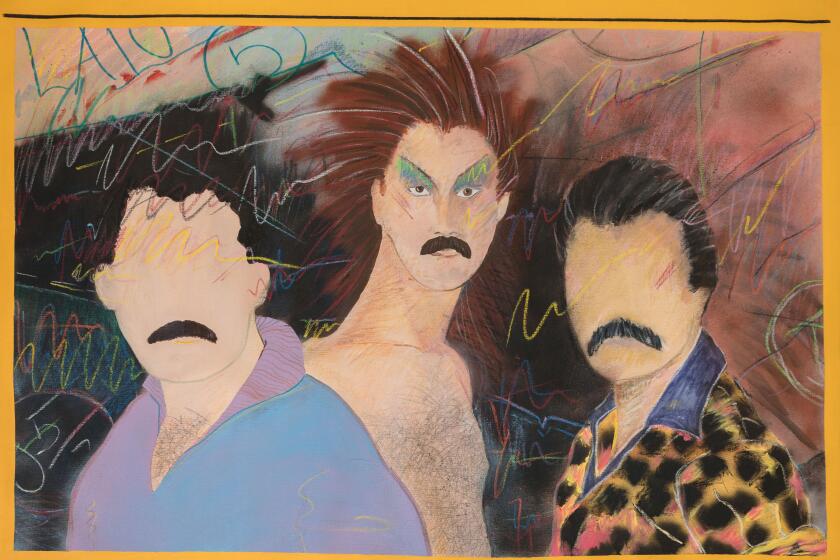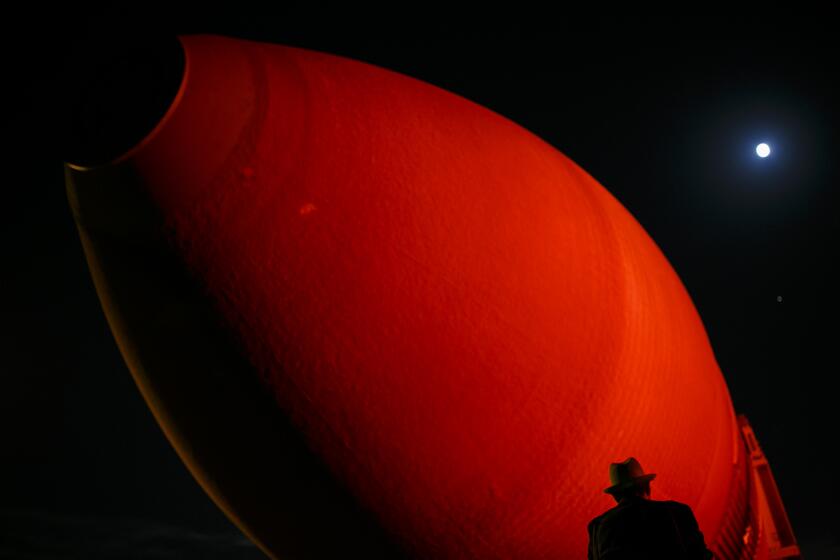L.A. artist Alexis Smith, a pioneer of art fusing image and text, dies at 74

Alexis Smith, the clever, much-exhibited Southern California conceptual artist who winningly combined found images and smart phrases since the 1970s, died Tuesday morning at home in Los Angeles, according to her studio manager, Erin Calla Watson. She was 74 and had had Alzheimer’s disease since 2015.
Smith created art on both an intimate and a large scale, indoors and outdoors, in traditional and untraditional settings. Her imaginative collages and assemblages have drawn on, not just borrowed — and sometimes edited — quotations by everyone from Milton to Kerouac and Gershwin, and also her recycling of such unexpected raw material as silverware, pressed flowers, seashells and discarded brooms.
“Alexis Smith brought her signature wit to spot-on observations about Hollywood, society and politics,” said Stephanie Barron, longtime senior curator of modern art at the Los Angeles County Museum of Art. “Smith’s engaging collages stand alongside the work of her eminent Southern California peers — Ed Ruscha, John Baldessari, George Herms and Mike Kelley — as emblematic of her time and place.”
Since her first solo exhibition at Riko Mizuno’s L.A. gallery in 1974, Smith’s work has been exhibited in dozens of solo exhibitions in Los Angeles, New York, Miami and elsewhere. Her 1991 Whitney Museum of American Art retrospective in New York traveled to the Museum of Contemporary Art in Los Angeles in 1992. And the Museum of Contemporary Art San Diego initiated its own Smith retrospective in 2022, an exhibition that Times critic Christopher Knight called “an absorbing thrill.”
“I think the West helped me form a sense of self,” Smith told museum executive Richard Armstrong, author of the 1991 Whitney Museum catalog. “I have assimilated so much of its history from my father and his family: its traditional pioneer values of individuality, being who you want and changing your life and doing what you please.”
Brought up on the grounds of a mental institution where her psychiatrist father was assistant superintendent, Smith grew up accepting eccentricity in herself as well as in her surroundings. And when she chose to attend the University of California, Irvine, in the late 1960s, she did so when the place was so new there was no tenured faculty and few rules about what was and wasn’t art.
The fledgling UC Irvine campus — an incubator of such radical artists as Chris Burden and Barbara T. Smith (no relation), where instructors included such future art giants as Robert Irwin and Vija Celmins — helped shape the young Alexis Smith.
Choosing UC Irvine when she did “turned out to be one of the defining moments in my life,” she has said. “Irvine was brand new, with a fledgling art department that didn’t have many facilities or technical support. It was really just working artists coming in and talking with us. It was like sitting under a tree with Socrates.
“Before that, I thought art had to be rigorous oil painting and stuff like that. I learned from artists like Bob Irwin and Vija Celmins that it was much more, something that you could invent yourself. And even though it sort of had to fit into a framework of what had been done before, that framework in the ’60s was really loose. Art seemed interesting because you could invent something, and when it stopped filling your needs, you could invent something else.”
Smith reinvented herself as well, changing her name when she was in college. Her birth name was Patricia Anne Smith, or Patti Smith, which she didn’t much like. “I didn’t really feel like a Patti, and I kind of wanted to distance myself as much as I possibly could from my unhappy adolescence,” she once said. “I found out there was a movie star named Alexis Smith, and some funny photos of her I started using in my work. Then, just gradually, I became Alexis Smith.”
The two women later met, and artist Smith said actor Smith “was very nice about it. She bought one of my early works that had a picture of her in it.”
The artist also called herself at various times “a reliable girl reporter.” Interviewed at length in the book “State of the Arts: California Artists Talk About Their Work,” she referred to “basically a kismet style of working. I free-associate, have these ideas playing in my head and look for things that make sense with them.”
Los Angeles writer Hunter Drohojowska-Philp has called Smith a “culture scavenger,” and she started young. As a child, she would pick up junk at construction sites and make collages out of words she cut from magazines. Later, the floors and tabletops of her longtime Venice, Calif., studio were similarly replete with such things as magazine covers, discarded watches and plastic containers of sequins and seashells.
Her work often centered on California and particularly Hollywood, usually in the context of people reinventing themselves. “I think that Americans as a group have this kind of Westward Ho mythology that you just keep going further west to the next new place whenever you get tired of the old place,” Smith has said. “California is the furthest place west, and I think that the advent of Hollywood really crystallized that myth.
“The Hollywood of the mind is this place where any soda jerk can become Clark Gable, and high school girls suddenly become movie stars. You can become anything you want, which allows people who are not brilliant or incredibly industrious to still have something wonderful happen to them.”
Writing in the Whitney Museum’s 1991 catalog, her friend and sometime collaborator, poet Amy Gerstler, said, “Alexis Smith is necessary; her work essential. Luckily for us, she sprang into existence somehow. If she hadn’t, we would have had to invent her.”
Smith’s first public project was comprised of mixed-media collages on and around a wall-sized locomotive in a West Hollywood savings bank in 1982, while her later large-scale mixed-media installation “Taste” covers three walls of the Getty Center restaurant. Her public work also includes the 560-foot-long “Snake Path” at UC San Diego and the terrazzo floors of the Los Angeles Convention Center and of Ohio State University’s Schottenstein Center.
Once asked why she would take on large public art projects, she replied: “I think it’s a good balance in terms of my work. I do small collages that I can control for a kind of elite audience of artists and museum people. But my big public pieces are for people who don’t necessarily choose to have an art experience. People come upon them very unexpectedly and have to puzzle them out.”
Smith also emphasized the teaching element of her work, telling one museum audience, “What I try to do is put ideas into this visual form so you can take them out and they will be your ideas because they’re not written. When somebody writes something, they give you the ideas and you can accept them or reject them, but with something like this, you can extract what I put in or get ideas I didn’t put in.
“If you do your art form well, it is smarter than you are. I’m stuck in my own time, but the art itself is much more flexible. It can be part of a zeitgeist that I won’t be part of. I’ve already lived long enough to see that happen. I really enjoy doing what I do, and it gives my life meaning. It’s a thing I made up, and it has provided me with the opportunity to have an interesting life.”
Smith is survived by her husband, artist Scott Grieger.
Isenberg, a former Times staff writer, is the author of “State of the Arts: California Artists Talk About Their Work” (William Morrow, 2000).
Alexis Smith, collage artist uprooted
The artist’s studio is part factory, part chapel, part Merlin’s cave, reliquary and museum. Some artists say it doesn’t matter where they make art. Others claim their studio is their art. Some cities preserve studios, but L.A. does not. We worship artists; we trade real estate.
Sunday is the 30th annual Venice Art Walk & Auctions, when artists open their studio doors for the public to peek at sanctum sanctorums in houses, lofts and commercial buildings. However, there is one less studio to visit -- lost to gentrification, a byproduct of the venerable walk. It was the work space and home of collage artist Alexis Smith.
At 17, Patti Anne Smith reinvented herself as Alexis, taking the name of a fading movie star. With this new identify, Smith became a living collage, a layering of her original self and a celebrity she’d never met.
In the 1970s, as minimalism collided with conceptualism, Smith studied with Vija Celmins and Robert Irwin at UC Irvine. Recycling discarded matchbooks, clippings, menus, playing cards, license plates, movie posters, swizzle sticks and bowling balls, Smith pioneered an approach to assemblage, making collages and installations that comment on the moral lapses and flimsy psychology of American culture. Aphorisms attached to her work are by the famous and infamous, from Walt Whitman and Charlie Chan to Richard Nixon and Prince. They are cryptic, witty and poignant.
Venice at the edge of the Pacific was founded as an amusement park in 1904. By the late ‘60s it was run down, cheap and dangerous, ideal for artists, hookers and drug dealers. In 1972, working for an architect named Frank Gehry, Smith moved into a storefront loft at 1907 Lincoln Blvd. The open room had a vibe. It had just been the workshop of techno-wizard Jake Brogan, then formulating prototypes for Gehry’s cardboard tables and chairs.
Smith became a star of a generation that includes L.A. artists Barbara Haskell, Chris Burden, Mike Kelly and Carole Caroompas. It took a lot of stuff to keep shining. She hoarded finds from thrift stores, back alley garbage bins, roadside diners, hotels, motels and restaurants. Everything came back to the loft where she lived and worked, cooking up her meals and her art. For three decades, Smith created work for shows on both coasts, including a retrospective at New York’s Whitney Museum of American Art.
Piles in the studio grew until thousands of doohickeys and whatnots were spread over tables, floors, sofas, the kitchen counter and the sleeping loft. The place became a complex collage, designed with a byzantine logic known only to the artist, who was raised by her father, a psychiatrist, on the grounds of a mental hospital in Norwalk.
In 2005, with no warning, Smith’s landlord served notice. He had sold 1907 Lincoln to a real estate firm. Smith had 30 days to vacate. All that she knew, all that she was making, lay on the floor and counters of a studio that was no longer hers.
Four weeks later, Smith turned in her keys, and the studio’s ordered chaos was shipped to garages and warehouses. After decades of gluing things together for galleries and museums, Smith’s life was unglued. What remains of her spiritual home is the made-on-a-Mac booklet created by her husband, L.A. artist and sage Scott Grieger, with digital images he took just days before the movers arrived.
Today, 1907 Lincoln still stands, its studio space gutted for offices. Smith is back with two simultaneous solo shows in L.A. What does she think about her loss? When called for comment, her machine answered: “There are the known knowns and the known unknowns. And then there are unknown unknowns, the things that we don’t know that we don’t know. A little Donald Rumsfeld brought to you courtesy of Alexis Smith. Leave a message.”
For Watters’ past columns, go to latimes.com/lostla.





No comments:
Post a Comment